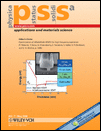FMR investigations of half-metallic ferromagnets
Abstract
Thin films of various half-metallic ferromagnets, such as chromium dioxide (CrO2) and Heusler alloys (Co2Cr0.6Fe0.4Al, Co2MnSi) have been investigated by ferromagnetic resonance (FMR) technique. It is demonstrated that FMR is a very efficient method to study the nanoscale magnetic properties, in particular to probe the magnetic anisotropy and magnetic inhomogeneities of ferromagnetic thin films. Epitaxial CrO2 thin films of various thicknesses (25–535 nm) have been deposited on TiO2(100) substrates by chemical vapor deposition process. It is shown that the magnetic behavior of the CrO2 films results from a competition between the magnetocrystalline and strain anisotropies. For the ultrathin CrO2 film (25 nm) the magnetic easy axis switches from the c-direction to the b-direction of the rutile structure. Thin-film Co2Cr0.6Fe0.4Al samples (25 nm or 100 nm) have been grown by DC magnetron sputtering either on unbuffered SiO2(100) substrates or on the substrates capped by a 50 nm thick V buffer layer. The effects of the vanadium buffer layer and of the film thickness are revealed by FMR studies of the Co2Cr0.6Fe0.4Al samples. Well-resolved multiple spin-wave modes are observed in the unbuffered Co2Cr0.6Fe0.4Al sample with a thickness of 100 nm and the exchange stiffness constant has been estimated. Thin films of Co2MnSi (4–100 nm) have been grown by DC sputtering on silicon substrates on top of a 42 nm thick V seed layer and capped either by Al2O3 or by Co and V layers. A set of the 80 nm thick films has been annealed at different temperatures in the range of 425–550 °C. FMR studies of the Co2MnSi samples shows that at the fixed annealing temperature (450 °C) the highest magnetization is observed in the sample with a thickness of 61 nm, while the thicker samples (100 nm) reveal not only a lower magnetization but greater magnetic inhomogeneity as well. An annealing treatment at T ≥ 450 °C is essential to obtain higher magnetization as well as uniform magnetic properties in the Co2MnSi films. Weak SWR modes have also been observed in the thick Heusler films. (© 2006 WILEY-VCH Verlag GmbH & Co. KGaA, Weinheim)




